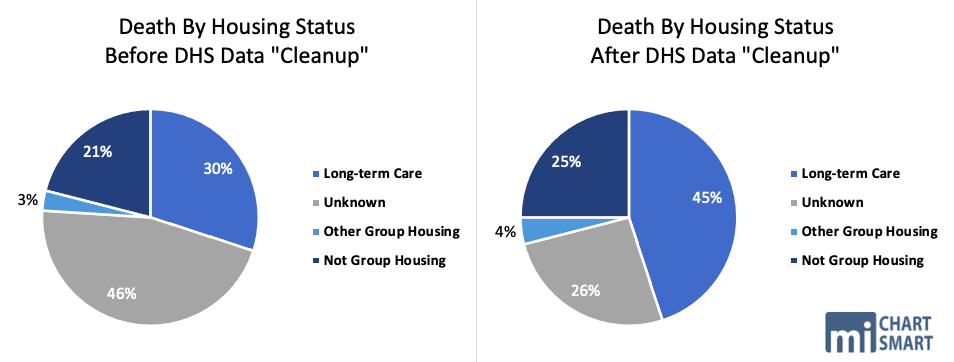
March 22, 2021
By Lexi Dittrich
The Wisconsin Department of Health Services (DHS) dumped a data “cleanup” on Wednesday that created a dramatic increase in COVID-19 deaths attributed to long-term care facilities (like nursing homes) and removed 2,200 confirmed cases from their COVID-19 case count.
Our researchers noticed the change on Wednesday. For the last several months, DHS had reported that around 30% of COVID-19 deaths were attributed to nursing home residents and around 46% of COVID deaths’ housing settings were unknown. Without warning on Wednesday, nursing home deaths jumped from 30% to 45% of the total death count, and deaths with “unknown” housing sharply fell from 46% of the death count to 26%. This means that over 1,000 COVID-19 deaths are now attributed to nursing home residences that were categorized differently the day before.
It wasn’t until Thursday, after already making their changes, that DHS issued a press release attempting to explain the discrepancy.
“As declining cases have allowed for increased staff capacity, an enhanced focus on data cleanup is under way,” DHS wrote. “Because of cleanup efforts, data displayed on the website changes over time. In particular, dashboards and data tables that track cumulative cases or deaths, as well as those showing newly reported “net” numbers each day may appear lower than expected – in some counties, substantially lower or even negative.”
Besides the drastic change in death settings, DHS’ “cleanup” included a net 2,200 “confirmed” cases that were subtracted from their case counts. “About 3,000 confirmed cases were corrected to probable over the past several weeks, and about 800 non-confirmed cases were corrected to confirmed over the same timeframe, leading to a net decrease of 2,200 confirmed cases,” DHS wrote.
DHS has a separate data table for probable cases, and those do not appear to be normally included in the state’s confirmed cases. We wonder, then, why probable, unconfirmed cases were included in DHS’ confirmed case log at all.
This is not the first time there has been delays and discrepancies with DHS’ COVID-19 data. DHS’ former Secretary Designee Andrea Palm first admitted that there was a local data backlog in several counties in July. Dane County was 10 days behind on entering their negative COVID-19 test results at the time. Had Dane County entered their backlogged negatives, their COVID-19 test positivity rate would have dropped from 5.5% to 2.1%.
“With all of this data, there are bumps in it,” Palm said in July, trying to justify the data delays.
MacIver caught DHS publishing more poorly-logged data in September. At the time, DHS calculated the state COVID-19 positivity rate by person tested, not by test. Hundreds of thousands of negative test results at the time had been tossed from the state positivity rate because of DHS’ calculation method. That meant the difference between a state test positivity rate of 7%, versus 4.8%. That had a huge impact on counties where officials based their economic reopening on that positivity rate.
While the DHS is now cleaning up their latest data backlog, it’s clear that Wisconsin is still facing the same issue after a whole year of COVID-19: Governor Evers, DHS, and local public health officials continue to issue emergency orders that restrict our economy, our education, and our way of life based on inaccurate, incomplete data.
DHS writes “Data is the tool that drives decisions for public health. And it has been vitally important to inform our decision-making process during the pandemic.” But how effective are their decisions and emergency orders if they’re built on poorly-reported data that is only corrected after the decisions are made?
Some members of Congress appear to have similar concerns and are now seeking more information on DHS’ delays and discrepancies in nursing home deaths data. Wisconsin Congressmen Fitzgerald, Tiffany, Steil, Grothman, and Gallagher wrote to Governor Tony Evers on March 22, “The failure to accurately classify these deaths obscured the truly dire situation in Wisconsin’s long-term care facilities. Had this information been accurately reported in real time, medical personnel could have targeted the limited supply of medical resources available to them toward long-term care facilities.”
As always, the MacIver Institute will continue to monitor and investigate the data that DHS and our state government are using to make serious public health decisions.